21 November 2023 In Asia, Blog Post
Tackling Transboundary Haze Pollution in Southeast Asia
By Dr. Supat Wangwongwatana, Air Pollution Expert, Faculty of Public, Thammasat University Senior Advisor, Thailand Environment Institute
Since early 1990, transboundary haze pollution has been a recurring challenge which poses significant social, economic, and environmental impacts to the Association for Southeast Asian Nations (ASEAN) and its sustainable development. Over the past 30 years, ASEAN Member States (AMS) has launched several regional initiatives to promote regional collaboration to address transboundary haze pollution, i.e. Regional Co-operation Plan on Transboundary Pollution adopted in 1995, Regional Haze Action Plan (RHAP) to prevent, monitor and mitigate land and forest fires adopted in 1997 , and ASEAN Agreement on Transboundary Haze Pollution (AATHP) to prevent and monitor transboundary haze pollution as a result of land and/or forest fires through concerted national efforts and intensified regional and international co-operation adopted and signed by all AMS in 2002, entered into force in November 2003 with the 6th ratification, and ratified by all AMS in January 2015.
A year later in 2016, the “Roadmap on ASEAN Cooperation towards Transboundary Haze Pollution Control with Means of Implementation” was adopted to operationalise the implementation of AATHP with the vision of a transboundary haze-free ASEAN (Measurable improvement of the situation of regional transboundary haze pollution) by 2020 and a goal to eliminate regional transboundary haze by intensifying collection action, supported with three indicators to measure progress and eight strategies for concrete and collective action at the national and regional levels. The Roadmap, with its extension from 2020 to 2023, has served as a strategic framework for the implementation of collaborative actions to prevent and control transboundary haze pollution in the ASEAN region between 2016-2023. Analysis of data obtained from ASEAN Specialized Meteorological Center (ASMC) shows that there has been very much improvements in the reduction of hotspot numbers (Figure 1 and Figure 2) and transboundary haze pollution situation (Figure 3) in the southern part of ASEAN but little improvements in its northern part (Mekong sub-region).
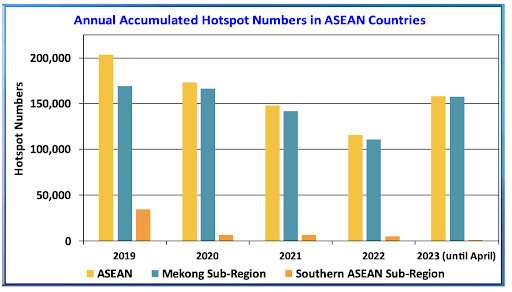
i.e. Mekong sub-region and Southern ASEAN sub-region (2019 - April 2023)
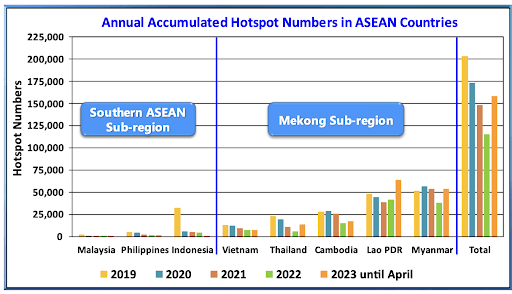
in sub-regions (2019 - April 2023)
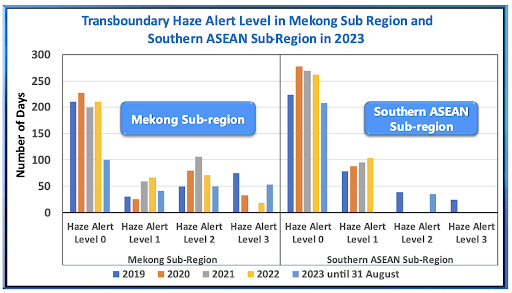
by sub- regions (2019 – August 2023)
Note:
Alert Level 0 = No transboundary smoke haze;
Alert Level 1 = Dry season;
Alert Level 2 = Increasing risk of transboundary haze in the region; and
Alert Level 3 = High risk of severe transboundary haze in the region
In 2021, the AMS noted the findings of the review of the Roadmap to evaluate progress in efforts to achieve the vision of a transboundary haze-free ASEAN by 2020 conducted between 2020 – 2021 and agreed to develop a Second Roadmap. The Second Roadmap (2023-2030) was developed during 2022-2023 and recently adopted by the AMS at the 18th Meeting of the Conference of the Parties to the ASEAN Agreement on Transboundary Haze Pollution (AATHP) in August this year.
The Second Roadmap to be implemented during 2023 – 2030 adopts multi-disciplinary and science-based approaches for a deeper and more meaningful understanding on the causes and consequences of haze and builds on relevant earlier experiences. It consists of updates to the vision, goal, targets and indicators, strategies, means of implementation, and a log frame to track progress with diverse policy instruments and the unique needs of subregions.
Two challenging targets and indicators of the Second Roadmap are to achieve national PM2.5 air quality targets with a view toward achieving the World Health Organisation’s annual and 24-hour Interim Targets 3 for PM2.5 with a significant and sustained reduction in the number of haze pollution episodes in ASEAN. To meet them, the Second Roadmap consists of nine mutually reinforcing strategies (Figure 4) with actions under each strategy which collectively enhance the implementation of the AATHP.
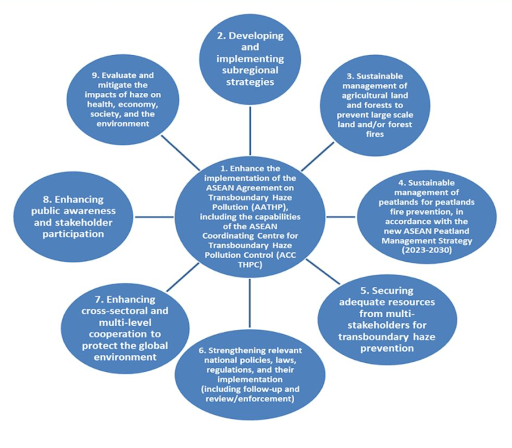
Transboundary Haze Pollution Control with Means of Implementation (2023 – 2030)
The success of the Second Roadmap in the improvement of the transboundary haze pollution situation in the Southeast Asia Region is subject to capacities, priorities and circumstances of the respective ASEAN Member States and the capabilities of the ASEAN Coordinating Centre for Transboundary Haze Pollution Control (ACC THPC) which is inescapable linked to the legally-binding obligations of the Parties of the AATHP.
ASEAN has provided a crucial platform for regional collaboration, fostering cooperation among member states to collectively tackle this critical issue in Southeast Asia. Transboundary haze pollution requires a coordinated response and these initiatives and frameworks have served as a testament to the commitment of member states in mitigating the root causes of haze pollution and enforcing preventive measures. The regional approach encourages shared responsibility, enabling nations to pool resources, expertise and technology. Overall, the ASEAN regional initiatives provide a structured and comprehensive framework for addressing transboundary haze pollution, showcasing the effectiveness of collective action in preserving the environmental well-being of Southeast Asia.
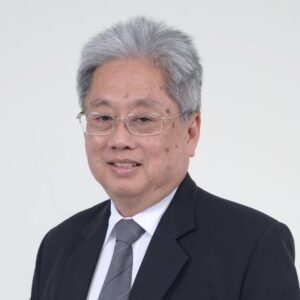
Supat Wangwongwatana
Dr. Supat Wangwongwatana is a Senior Specialist in air pollution at the Faculty of Public Health, Thammasat University since 2017. He has been working for 30 years to improve air quality in Thailand and throughout Asia. Dr. Wangwongwatana is a Senior Advisor to the Thailand Environment Institute. He received his Ph.D. in Environmental Science from the University of California, Riverside, USA. Dr. Wangwongwatana is a scientist and practitioner who has worked to institutionalize air quality management in Thailand and is an esteemed role model for air quality management scientists and practitioners in cities and countries across Asia. He was awarded the 2016 Kong Ha Award for Excellence in Air Quality Management.